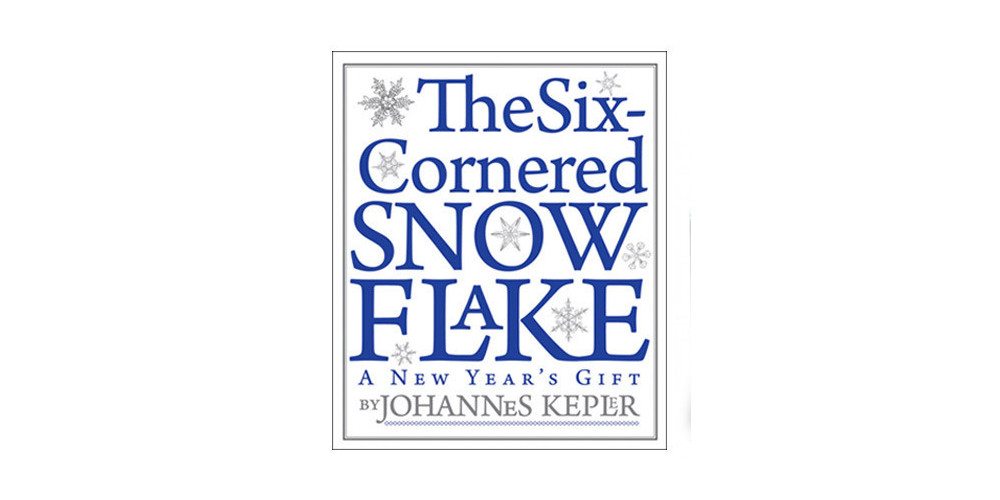
Want some light reading but prefer non-fiction? Here are two really engaging books that tackle deep math and science topics with an air of lightheartedness and curiosity.
The Six-Cornered Snowflake: A New Year’s Gift by Johannes Kepler
Yes, that Johannes Kepler. When he wasn’t formulating laws of planetary motion, Kepler was studying snowflakes.
Kepler’s essay, written in 1611, is collected together in a book which includes several other essays for us to enjoy. Each of the other pieces helps put Kepler’s essay in context, and shares with us other people’s ideas about formerly-mysterious snowflakes.
This book begins with an interesting look at Kepler’s career in an essay entitled “The Delights of a Roving Mind” by Owen Gingerich. It then dives into an essay, “On ‘The Six-Cornered Snowflake'” by Guillermo Bleichmar, which goes into the line of inquiry that Kepler took to discover why there are always six corners to a snowflake. His contemplation of the subject, as it were.
Next in the book is Kepler’s essay itself, which I’ll get into in a minute.
Next are several detailed snowflake illustrations by Capi Corrales Rodrigáñez, and then, finally, an interesting poem by John Frederick Nims entitled, what else, “The Six-Cornered Snowflake.” Each stanza is on its own page and shaped in a six-cornered snowflake, complete with asterisks on the corners for emphasis. Now on to Kepler’s essay.
Kepler’s school background didn’t demonstrate an ability for astronomy above other subjects, but those at the university thought that his ways of thinking could lead to some interesting work in the field. It probably helped that he was one of few who agreed with Copernicus’s sun-centered solar system. So off he went to teach astronomy. So, while he is best known for his three laws of planetary motion, his brain thought in scientific ways on all kinds of topics.
Filling the bulk of the volume, the essay has been translated into English by Jacques Bromberg. Each spread has the original Latin text on the left and the English translation on the right. The whole essay began as a gift to Kepler’s friend Lord Matthäus Wacker von Wackenfels, who was part of the court of Rudolph II in Prague, so Kepler begins by addressing his friend.
“I am well aware how fond you are of Nothing…” he begins. This whole section has many marked notes, which are quite useful in explaining more about what Kepler is saying at any given point. They aren’t just notes pointing to other reference material.
Kepler goes on to contemplate the existence of the snowflake and its properties. He does so with flowery prose and a heavy dose of wit. He references Greek philosophers frequently. And then he gets down to business. Why are snowflakes six-sided?
Kepler studies other things in nature with regular shapes, such as the honeycomb design and pomegranates (including drawings in the essay), flowers and fruits, and more, with great analysis. He ponders and ponders. He looks at geometric solids. Imagine what it would have been like to live during a time when they were still discovering some basic tenants of science?
The essay is filled with a lot of the study of math and science. The questions he presents about snowflakes weren’t answered for another 300 years. But his wonderings were important during this time of discovery. The essay is filled with question after question, and observation after observation as he tries to understand what causes these interesting natural occurrences. He devises explanations, but realizes the faults in his logic for them. In the end, he realizes that much still needs to be thought of and discussed on the matter before the true reasoning will be discovered. Kepler asks for his friend’s input as well.
If you like reading about this history of math or science, this essay on snowflakes gives us a unique look into the mind of the great astronomer, Johannes Kepler. It’s a quick read, so don’t pass it up.
The Six-Cornered Snowflake: A New Year’s Gift would be a fun stocking stuffer for your favorite science or math nerd, or great for self-study on the history of science.

The Education of T.C. Mits {The Celebrated Man in the Street}: What Modern Mathematics Means to You by Lillian R. Lieber and illustrated by Hugh Gray Lieber
Published in 1942, this whimsical look at mathematics includes unusual ways of looking at things, teaching us how sometimes the angles of a triangle add up to more than 180 degrees, and how two plus two is not always four. It covers topics in arithmetic, Algebra, Calculus, and Geometry in a most unconventional way.
Filled with fun line drawings by the author’s husband, the whole book is in what looks like free verse poetry, but the author claims the lines are broken that way to facilitate quick reading, because “everyone is in a hurry nowadays.” There was also an early, small GI version published for the World War II soldiers that would fit inside an empty pack of K-rations, perfect for educating a whole group of people on the go.
This book teaches much of the essence of mathematics without going into much of the detail. It will be a fun and successful introduction for some, and an entertaining refresher for others. Each section has some drawings and plenty of thought-provoking text. The author presents a logical math-y problem, and then challenges the reader to think about it and come up with the answer, before turning the page. On the next page, the answer is then explained and summed up in a moral at the end.
Full of thought experiments that get you thinking about math, this book is also more than about math. It gets you thinking about people and how they think, are, and act. There are morals such as don’t jump to conclusions, always check your facts and not assume your hunch is right, and don’t be a slave to traditions.
The Education of T.C. Mits {The Celebrated Man in the Street}: What Modern Mathematics Means to You would be a great gift for a high school student or graduating senior, or for adults who like math. Some of the chapters can also easily be shared with younger students, going through the thought experiments as a family.
Note: I received these books for review purposes.





Very good and high quality text with great tips. Thank you very much, it is important to me.